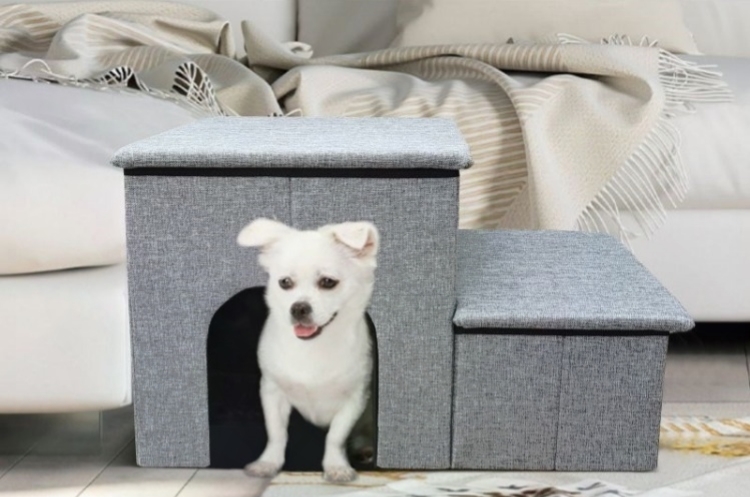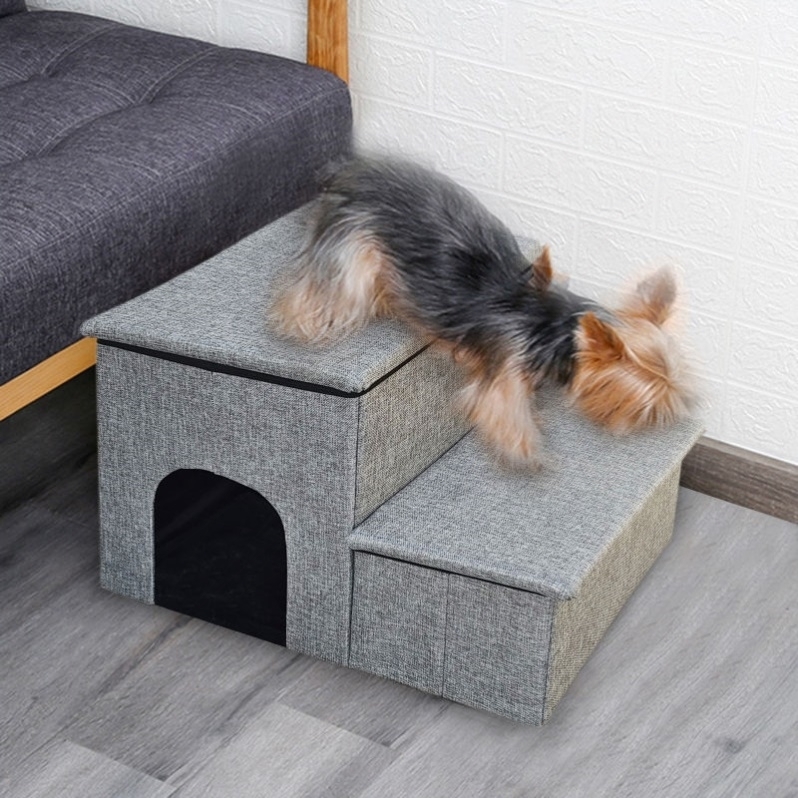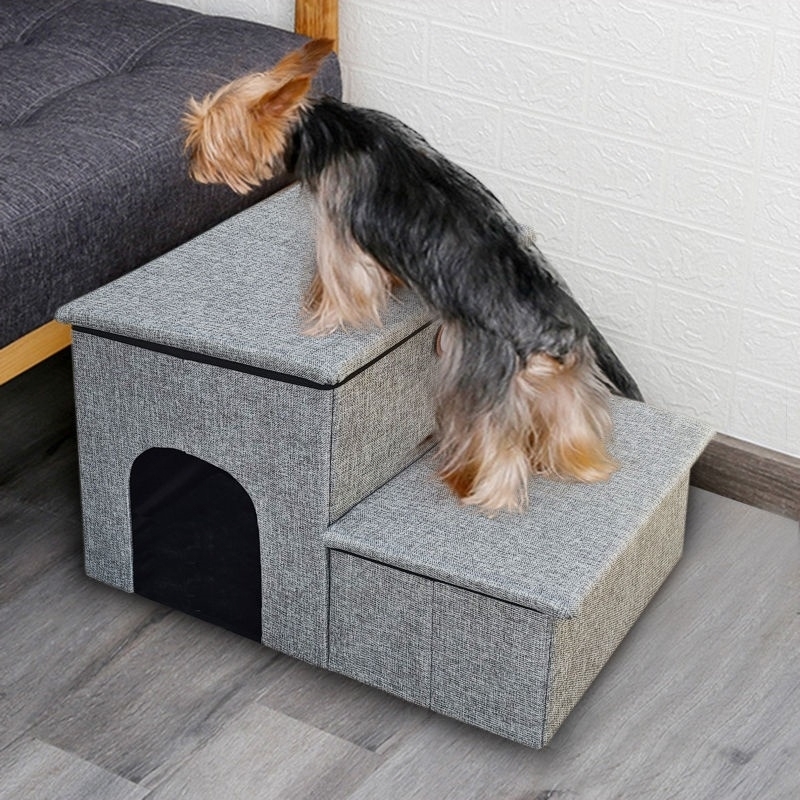
Keeping It Clean: Maintenance and Cleaning Tips for Your Dog’s Bed Ramp
For many pet owners, a dog ramp is more than just a convenience—it’s a lifeline, ensuring our furry friends can comfortably access their favorite lounging

For many dog owners, watching their furry friend struggle to climb onto a bed or couch can be heart-wrenching. As our pets age or face mobility challenges, simple tasks can become daunting hurdles.
Thankfully, innovative solutions like ramps and stairs have emerged to aid our canine companions.
But with multiple options available, how does one decide between a ramp and stairs? Which is more suitable for your dog’s specific needs and bedtime routine? Both come with their unique advantages, tailored to different breeds, ages, and physical conditions.
In this article, we’ll delve deep into the world of dog bed accessibility, comparing ramps and stairs head-to-head. By understanding the pros and cons of each, you’ll be better equipped to make an informed decision, ensuring your pet’s bedtime routine is both safe and comfortable.

Consider your dog’s current physical condition and limitations when selecting access methods:
If your dog is still fairly agile and active, stairs may be easily manageable. Dogs with more progressive mobility issues often benefit more from more gradual ramps.
Larger and overweight dogs tend to find ramps gentler and lower impact than stairs. Smaller dogs often handle stairs fine if not overly steep.
Weakened rear legs, arthritis, neurological conditions and injuries affect balance and coordination. Ramps provide more stability and support.
During post-op recovery or while healing injuries, ramps put less strain on surgical sites, joints and soft tissues.
As dogs enter senior years, their needs evolve. Customizable ramps can be adapted as mobility changes over time.
Ramps offer several advantages for easier and safer bed access:
The gently inclined slope of ramps requires less lifting of the rear legs with each step, putting less strain on hips, knees and ankles.
Most ramps have textured surfaces and carpeting for better paw grip than hard stairs. Some have anti-slip side rails dogs can brace against.
Ramps provide more room for dogs to comfortably distribute their weight and avoid slips. Stair widths are limited.
The slope of ramps can be adjusted to the easiest angle for a particular dog. Stair steepness is fixed.
Walking up ramps eliminates the jarring force of hard stair landings and awkward movements dogs make using stairs.
Dogs who start to struggle with stairs can lose confidence. Ramps allow them to retain independence by getting to bed.
In some situations, stairs have advantages over ramps:
If your dog has safely used particular stairs their whole life, staying with what they know may be easier than introducing something new.
Little dogs often have an easier time hopping up stairs than navigating the length of long ramps designed for larger breeds.
Where space is very tight, a short stair option may be the only feasible choice. Ramps need extended floor space.
Basic pet stairs are often more affordable than more complex ramps. But ramps tend to be a longer-term investment in joint health.
For very tall beds off the ground, long ramp runs would be needed. Stairs may reach high beds more efficiently.
If your dog is still very active and athletic, properly sized and surfaced stairs provide enriching agility work.

If using stairs, follow these precautions:
Dogs should be able to ascend stairs without excessive lifting of the rear legs on each step.
Apply non-slip treads to wooden stairs. Choose textured stairs or add carpeting.
Avoid wobbly, shifting stairs. Dogs gain confidence in sturdy structures that won’t collapse or sway.
Position stairs at a right angle to the bed rather than flush against them for easier access.
Dogs need to be able to place 3 paws at a time on wider stair treads for stability and leverage.
Supervise dogs on stairs until you are sure they can ascend and descend safely. Provide assistance as needed.
Certain factors are important when selecting and using ramps:
Aim for ramp angles under 30 degrees. Measure and adjust to find the easiest incline for your dog.
Look for textured ramp treads, cross-hatched mats, turf or carpets to prevent slips.
Ramps with side rails or raised edges provide balance assistance that dogs can push against.
Measure your dog on a sample ramp. The ramp deck should be wide enough for them to stand comfortably without slipping off the sides.
Work on-ramp training in small sessions, using treats to motivate and reward. Avoid forcing dogs up steep inclines. Go at their pace.
Beyond ramps or stairs, a few extra techniques can also help dogs access beds:
Choose beds with built-in gradual inclines or sloped front edges to reduce the full height dogs need to traverse.
Strategically place surrounding chairs, ottomans and stools to create staggered intermediate steps up to the bed surface.
Securely position crates, benches or sturdy steps adjacent to beds to provide an intermediate hop-up.
Elevated beds that securely anchor into studs on the wall remove any worries about equipment shifting under your dog.

Navigating the world of pet accessibility has been an enlightening journey. As we’ve dissected the merits and drawbacks of both ramps and stairs, it’s evident that there isn’t a one-size-fits-all answer. The best choice hinges on your dog’s unique needs, physical condition, and the environment in which they live.
Ramps, with their gentle incline, can be a godsend for senior dogs or those with joint issues, offering a seamless transition without the jarring impact of steps. On the other hand, stairs might be more suitable for younger dogs or those with a bit more spring in their step, especially when space constraints come into play.
But beyond the physical considerations, it’s essential to factor in your dog’s confidence and comfort. Some dogs might naturally gravitate towards one solution over the other. Observing their behavior and preferences can provide invaluable insights.
In the end, whether you choose a ramp or stairs, the primary goal remains unchanged: ensuring your pet’s safety and comfort. It’s about granting them the independence to access their favorite spots without strain or discomfort. As pet owners, our responsibility is to make informed decisions that enhance our pets’ quality of life.
In conclusion, the debate between ramps and stairs isn’t about determining a superior option but about finding the right fit for your furry friend. By weighing the pros and cons, understanding your dog’s needs, and being open to a bit of trial and error, you can find the perfect solution that makes bedtime a dream for both of you.

For many pet owners, a dog ramp is more than just a convenience—it’s a lifeline, ensuring our furry friends can comfortably access their favorite lounging

In today’s design-conscious world, every piece of furniture and accessory in our homes is a reflection of our personal style. So, why should our pet

Bringing home a new dog ramp for your pup’s bed takes some initial training so they learn how to use it properly. Ramps are unfamiliar

Getting the properly sized dog ramp is crucial for providing safe and easy access to beds and furniture. Ramps that are too steep or too

For many dog owners, watching their furry friend struggle to climb onto a bed or couch can be heart-wrenching. As our pets age or face

For many pet owners, a dog ramp is more than just a convenience—it’s a lifeline, ensuring our furry friends can comfortably access their favorite lounging

In today’s design-conscious world, every piece of furniture and accessory in our homes is a reflection of our personal style. So, why should our pet

Bringing home a new dog ramp for your pup’s bed takes some initial training so they learn how to use it properly. Ramps are unfamiliar
Copyright © 2024 pawclimbdogbedramp. All Rights Reserved.